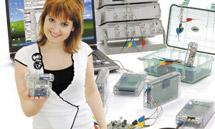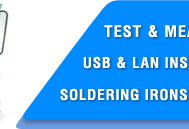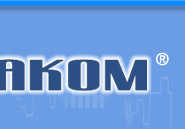|
|
ASE-4204 ESD-Safe Temperature Controlled Multifunctional Rework Station
ASE-4204 ESD-Safe Temperature Controlled Multifunctional Rework Station
|
|
ESD-safe temperature controlled multifunctional rework station. Especially recommended for work with temperature sensitive electronic components such as IC, QFP, SOP, etc. Equipped with high-quality durable easy replaceable heating element. Vacuum pump of high capacity is perfect for the work with multilayer printed circuits. Temperature range: 392-896°F / 200-480°C. 760W. AC220V±10%; 50Hz/60Hz.
Manuals:
|
|
Since soldering and rework processes when repairing electronics are usually made sequentially by one specialist it’s obviously convenient to use a universal system combining the features necessary for both operation types.
AKTAKOM ASE-4204 professional multifunction station unites in one block a soldering station and rework equipment. This allows ASE-4204 to occupy a minimal space and organize a high performance work area.
AKTAKOM ASE-4204 soldering and rework station is ESD-safe. This is an important requirement that should be met since the absence of antistatic protection may cause the damage of valuable electronic components with electro static discharge.
ASE-4204 rework station has a hot air gun and a soldering iron accordingly. It is especially recommended for work with temperature sensitive electronic components such as IC, QFP, SOP, etc.
Features:
- 2 in 1 rework station
- Volume and temperature can be adjusted to solder IC, QFP, SOP.
- ESD-safe. Suitable for work with static-sensitive components
- High-quality heating element that can be easily replaced
- Temperature can be easily adjusted
- The indicator will blink rapidly when the temperature reaches the desired value.
- The fan will still work for a moment after you finish your work and power off the station. This can extend the life of the heater and the handle.
Specifications:
- Power consumption: 760W
- Output voltage: AC220V±10%; 50Hz/60Hz
- Temperature range: 392 to 896°F / 200 to 480°C
- Airflow volume: 24L / Min (Max)
- Noise: <45 dB
- Dimensions: 13x10.8x7.7 in / 330x275x195 mm
- Weight: 8.2 lb / 3.7 kg
Included accessories
- Control unit with air gun
- Air gun holder
- Soldering iron
- Iron holder
- Iron cleaning sponge
- Air gun nozzles (3 pcs.)
- User manual
| ASE-4204 ESD-Safe Temperature Controlled Multifunctional Rework Station - rear view |
|
|
| ASE-4204 ESD-Safe Temperature Controlled Multifunctional Rework Station - side veiw |
|
|
| ASE-4204 ESD-Safe Temperature Controlled Multifunctional Rework Station |
|
|
|
Safety instructions
Take care of yourself!
- Please read user manual carefully before using the instrument.
- Do not use the device if there is visible damage.
- Repair and maintenance of the device can be done only by a qualified specialist of the service center.
- Before connecting the instrument to the electrical network, observe all known precautions, and make sure that the grounding system is to avoid electric shock.
- Use only those accessories that are intended for use with this device.
- While working, do not touch the metal parts near the tip of the soldering iron.
- After completion of the work, it is necessary to install the soldering gun in the regular holder of the soldering gun.
Frequently Asked Questions
How to care and use of the soldering tip?
How to clean the tip?
What temperature should use for soldering?
Why a "de-tinned" tip fails to work?
| How to care and use of the soldering tip? |
|
High soldering temperatures can degrade the tip. Use the lowest possible soldering temperature. The excellent thermal recovery characteristics ensure efficient and effective soldering event at low temperatures. This also protects the sensitive components from thermal damage. Clean the tip regularly with a cleaning sponge, as oxides and carbides from the solder and flux can form impurities on the tip. These impurities can result in defective joints or reduce the tip's heat conductivity. When using the soldering iron continuously, be sure to loosen the tip and remove all oxides least once a week. This helps to prevent reduction of the tip temperature. Never leave the soldering iron sitting at high temperature for long periods of time, as the tip's solder plating will be covered with oxide, which can greatly reduce the tip's heat conductivity. Wipe the tip and coat it with fresh solder after use. This helps to prevent tip oxidation.
Up
|
| How to clean the tip? |
|
Caution! Never file the tip to remove oxide.
- Set the temperature to 250°C.
- When the temperature stabilizes, clean the tip with the cleaning sponge and check the condition of the tip.
- If there is black oxide on the solder-plated portion of the tip, apply new solder (containing flux) and wipe the tip on the cleaning sponge. Repeat until the oxide is completely removed. Coat with new solder. The solder protects the tip from oxidation and prolongs the life of the tip.
- If the tip is deformed or heavily eroded, replace it with a new one.
Up
|
| What temperature should use for soldering? |
600°- 650°F (316°- 343°C) is a good place to start for lead-based solder and 650°- 700°F (343°- 371°C) for lead-free solder.
Note: if clots form, the temperature is too low.
Up
|
| Why a "de-tinned" tip fails to work? |
|
A de-tinned tip is one which cannot wet with solder. This exposes the plating to oxidation and degrades the heat transfer efficiency of the tip.
The de-tinning is caused by:
1) Failure to keep the tip covered with fresh solder while not in use.
2) High tip temperatures.
3) Insufficient melting in soldering operations.
4) Wiping the tip on dirty or dry sponges and rags (Always use a clean, wet, industrial grade, sulfur-free sponge).
5) Impurities in the solder, iron plating, or on the surfaces to be soldered.
Up
|
Back to the section
|
|















